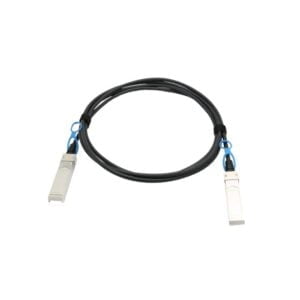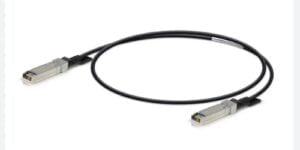Table of Contents
There are various connection solutions available for switching networks, such as optical modules + optical fibers, Active Optical Cables (AOC), and Direct Attach Cables (DAC). DAC can be further categorized into active ACC, AEC, and passive DAC. So, what exactly are these solutions and how do they differ? Today, we will explore their features and benefits.

Understand of Active Optical Cable (AOC)
What is Active Optical Cable (AOC)?
Let’s start with AOC, which stands for Active Optical Cable. AOC consists of two modules on either end, connected by a section of optical fiber in the middle. The optical module and optical cable are integrated, and laser components are required for both ends’ optical modules.
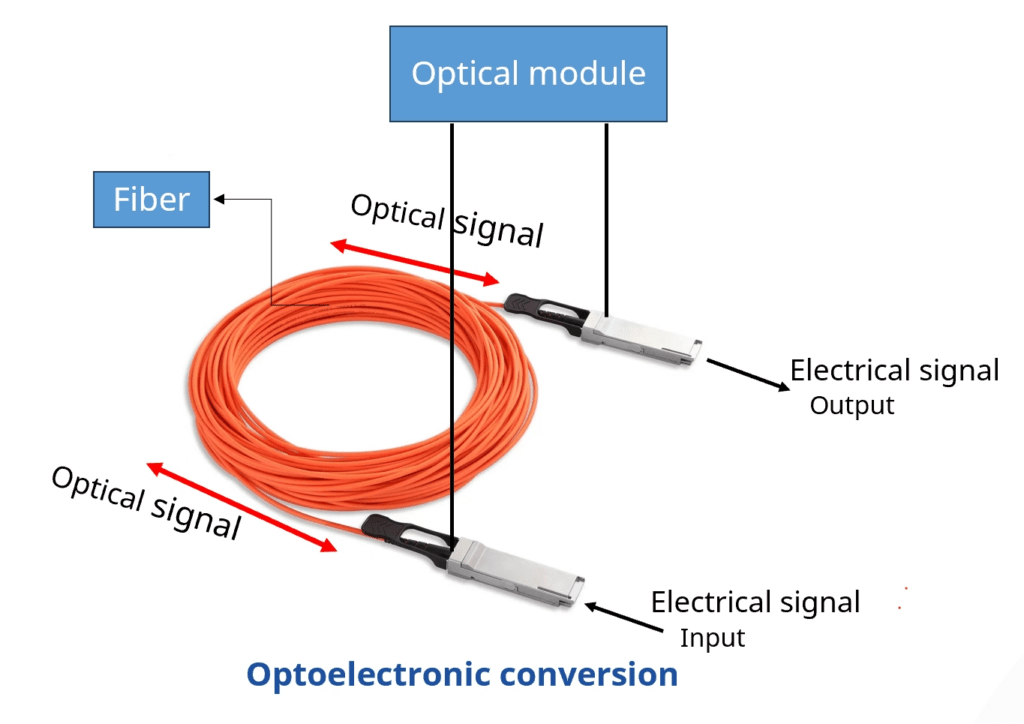
AOC is designed to eliminate the possibility of optical port contamination and enhance reliability. It is an optimized solution that balances cost and performance by reducing the number of optical components and removing the DDM (Digital Diagnostic Monitoring) function.
AOC Advantages and Application Scenario
When compared to other cables, AOC offers numerous advantages. It provides high transmission rates, long-distance capabilities, low power consumption, lightweight, and ease of use. These benefits are made possible by the adoption of optical transmission, which overcomes limitations present in passive fiber optic cables or other cable types.
Due to its lightweight and compact design, AOC is becoming increasingly popular in data centers and high-performance computing (HPC) applications. Traditional copper-based technologies are being phased out as they tend to be heavy, bulky, and inefficient. In data centers where space is limited, AOC meets the requirements for high-density connectivity. Moreover, copper cables are prone to electromagnetic interference (EMI), which hampers data transmission speed and increases packet loss. Therefore, AOC active optical cables are the ideal choice for IDC data centers, HPC environments, and InfiniBand switch interconnections.

AOC Classification
- 10G SFP+ AOC
- 25G SFP28 AOC
- 40G QSFP+ AOC
- 40G QSFP+ to 4xSFP+ AOC
- 100G QSFP28 AOC
- 100G QSFP28 to 4xSFP28 AOC
- 100G QSFP28 to 2x50G QSFP28 AOC
- 200G QSFP56 AOC
- 200G QSFP28-DD to 2xQSFP28 AOC
- 400G QSFP-DD AOC
- 400G QSFP-DD to 4xQSFP56 AOC
I believe you have already uncovered it. There exists a scenario where 40G can be divided into 4×10G, 100G can be divided into 4×25G or 2x 50G QSFP28 AOC; 200G can be divided into 2*100G, and 400G can be divided into 4×100G. This allows for the conversion of one high-speed port into four low-speed ports, facilitating the interconnection of switches with different-speed ports.
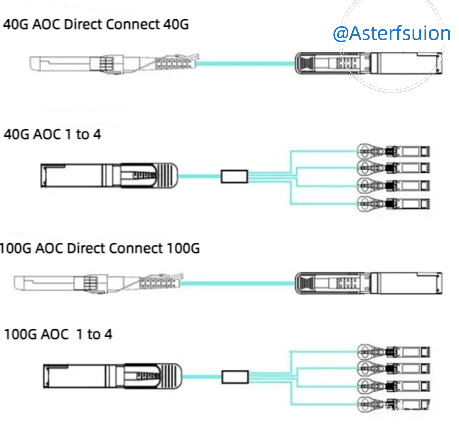
Disadvantages of AOC
With that being said, there are both advantages and disadvantages to consider. AOC optical port remains concealed, resulting in no need for port cleaning or concerns about contamination. This greatly enhances system stability and reliability. However, the downside of AOC is also evident in this aspect. Since the AOC module is directly connected to the cable, if it becomes faulty, the entire module needs to be replaced, which is a major drawback compared to the optical module + jumper connection.
Additionally, AOC requires the confirmation of transmission distance before shipment, making it difficult to adjust the products once they leave the factory.
Moreover, due to its utilization of optical signal transmission and involvement with photoelectric conversion, the design and processing technology of AOC are more complex. Consequently, compared to the later-mentioned DAC, AOC incurs higher costs and power consumption.
Understand of Direct Attach Cable(DAC)
What is a Direct Attach Cable(DAC)?
DAC, also known as Direct Attach Cable, is composed of high-speed cables made of silver-plated copper conductors and foam insulated core wires. The ports of this cable are not replaceable, and the module head and the copper cable cannot be separated.

DAC cables can be categorized into two types: Passive Copper Cable (PCC) and active DACs.

Active DAC can be further divided into Active Copper Cable (ACC) and Active Electrical Cable (AEC), which will be explained later!
Both passive and active DAC cables can directly transmit electrical signals over copper cables. While the former can transmit without signal conditioning, the latter is equipped with electronics inside the transceiver to enhance the signal. When referring to DAC below, it is specifically referring to PCC, unless otherwise specified.
Features and Applications of DAC
DACs do not incorporate optoelectronic converter modules, and the cable ends consist of simple cable connectors. This makes them highly cost-effective. In data centers, copper cables are commonly employed to connect servers and storage area networks. Due to their affordability and high-speed capabilities, passive copper cables have emerged as the optimal solution for achieving short-distance transmission. The primary application scenarios focus on interconnections within 5m/10m.
DAC Classification
- 10G SFP+ DAC
- 25G SFP28 DAC
- 40G QSFP+ DAC
- 40G QSFP+ DAC
- 40G QSFP+ to 4x SFP+ DAC
- 100G QSFP28 DAC
- 100G QSFP28 to 4xSFP28 DAC
- 100G QSFP28 to 2x50G QSFP28 DAC
- 200G QSFP56 DAC
- 200G QSFP28-DD to 2x QSFP28 DAC
- 400G-DAC-QSFP-DD
- 400G QSFP-DD to 2x QSFP56
- 400G QSFP-DD to 4x QSFP56 DAC
DAC and AOC are the same, 40G can be breakout into 4 × 10G, 100G can be breakout into 4 × 25G 100G QSFP28, 2x 50G QSFP28 DAC; 200G can be breakout into 2 * 100G, 400G can be breakout into 4 × 100G. Turn a high-speed port into 2 or 4 low-speed ports to facilitate the interconnection of switches with different rate ports.

Advantages and Disadvantages of DAC
Advantage:
- High-speed transmission: DAC data cables typically support data transfer rates up to tens of Gbps, offering faster bandwidth and transmission speeds compared to traditional copper and fiber optic cables.
- Cost-Effectiveness: When compared to fiber optic modules and cables, DAC data cables are generally more affordable, making them a cost-effective solution for high-speed connections, especially over shorter distances.
- Low power consumption: Unlike optical fiber modules that rely on the photoelectric conversion process, DAC data cables transmit electrical signals with relatively low power consumption, contributing to reduced energy usage in the entire system.
- Efficient heat dissipation: The high-speed cables made with copper cores have excellent heat dissipation capabilities, ensuring effective cooling.
Shortcomings:
- Distance limitation: Due to its reliance on copper cable media, DAC data cables are limited in terms of electrical signal transmission distance. They are primarily suitable for short-distance connections (less than 7 meters) and are not ideal for long-distance transmission.
- Limited flexibility: DAC data cables are typically bulky and rigid, lacking the flexibility of optical fiber cables. Consequently, they are not suitable for applications that involve frequent bending or flexing.
- Susceptibility to electromagnetic interference: Since DAC data cables utilize copper cable medium, they may be susceptible to electromagnetic interference, especially in high-density wiring environments. This interference can potentially impact the stability and reliability of data transmission.
These limitations of DAC data cables have led to the demand for ACC AEC modules, which we will discuss in more detail later.
AOC/DAC Comparison
| Comparison Item | AOC | DAC(passive) |
| Transmission Signal | Optical Signal | Low Voltage Pulse Signal |
| Transmission Medium | Optical Fiber (Quartz) Insulated, belongs to fiber optic communication, not affected by electromagnetic interference. | Copper Cable, DAC high-speed cables use copper material, belong to electrical communication, and are affected by electromagnetic interference. |
| Power Consumption | High | Low |
| Transmission Distance | AOC (OM3) transmission distance is generally up to 100 meters, within 300 meters. | Passive DAC: Maximum 7 meters |
| Price | High | Low |
| Size | AOC active optical cable weighs about one-quarter of DAC high-speed cable and has about half the volume, making it easier to route and transport. | Bulky than AOC |
| Transmission Performance | High: AOC active optical cable has a lower bit error rate than DAC high-speed cable. | Low |
| Device Differences | AOC active optical cable contains a laser. | DAC high-speed cable has no optical components. |
Understand Active Copper Cable(ACC)& Active Electrical Cable(AEC )
Why we need ACC and AEC?
Since the advent of the 40G era, passive copper cables known as DAC have played a crucial role in facilitating communication links within data centers. These cables offer numerous advantages, such as their low power consumption and affordability, which have remained consistent even in the current 800G era. However, with the increase in speed and bandwidth, the transmission distance of DAC has been somewhat limited. In the transition from 400G to 800G, the DAC transmission distance has been reduced from 3m to 2m.
Moreover, as the number of channels in DAC has expanded from 4 to 8, and eventually to 16, the cable diameter has nearly doubled. This larger diameter can obstruct wiring and airflow within the cabinet, leading to inconveniences during maintenance. It should be noted that simply improving the materials and processes employed in DACs cannot sufficiently enhance their transmission performance at a rate that matches the growth of signal rates.
While active optical cables (AOC) have been proposed as a potential long-distance transmission medium for data centers, their high power consumption and cost prevent them from being an excellent alternative for mid-range distance transmission. Driven by the need to address this issue, communication cable manufacturers, in collaboration with data centers and chip manufacturers, have introduced active copper cables specifically designed for medium and short-distance transmission. These active copper cables offer an alternative solution that achieves the desired medium and short distance transmission, while still maintaining low power consumption and affordability.
Currently, there are two types of active DACs available in the market: ACC-Active Copper Cable and AEC-Active Electrical Cable.
What is ACC & AEC ?
- ACC-Active Copper Cable is an active copper cable that utilizes Redriver chip architecture and employs CTLE equalization to adjust the gain at the Rx end. In essence, it functions as an active cable that amplifies analog signals.
- AEC-Active Electrical Cable represents a more innovative approach to active copper cables. It utilizes Retimer chip architecture, which not only amplifies and equalizes the Tx and Rx terminals but also reshapes the signal at the Rx terminal.
ACC/AEC Technical Principles
Let’s begin with ACC’s Redriver, which is designed to compensate for loss by utilizing CTLE on the Rx side and a driver on the Tx side. This results in an expanded window for the eye diagram, ultimately reducing the attenuation of the entire PCIe channel. Think of the Redriver as a linear amplifier that amplifies the signal without altering or diminishing the noise present in the cable.

In contrast to the Redriver, AEC’s Retimer chip not only incorporates CTLE and wideband gain nodes but also features CDR and a DFE (Decision Feedback Equalizer). It utilizes an FSM (finite state machine) or microcontroller to automatically adapt the CTLE, wideband gain nodes, DFE, and FIR drivers.
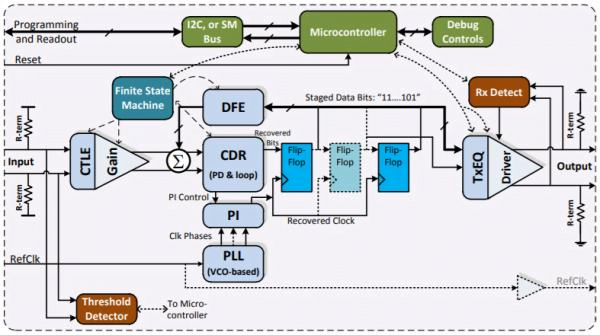
Compared to the Redriver, Retimer devices are capable of reconditioning data signals, eliminating noise, and achieving exceptionally clear data transmission. For single-channel rates of 112G PAM4, a retimer with CDR functionality (including DSP-based retimers) is a necessity. However, it is important to note that complex retimers may introduce added delays and incur higher costs compared to Redrivers.

AOC/DAC/AEC Comparison
| Comparison Item | AOC | DAC(Passive) | AEC |
| 400G Transmission Distance | <300m | <3m | <7m |
| 800G Transmission distance | <300m | <2m | <2.5m |
| Power Consumption | High | Low | Low |
| Cost | High | Low | Medium |
| Weight | 25% of the weight of a DAC | The higher the bandwidth, the larger the wire diameter, the heavier the weight. | 800G AEC quality is only 25% of DAC |
| Lifetime | Short | Long | long |
Asterfusion AOC Model
| Product | Cable Type | Max Data Rate | Cable Length |
| AOC-10G-10G-MM850 | OM3 | 10Gbps | 1m, 3m, 5m, 10m |
| AOC-25G-25G-MM850 | OM3, OM4 | 25Gbps | 1m, 3m, 5m, 10m |
| AOC-40G-40G-MM850 | OM3 | 40Gbps | 1m, 3m, 5m, 7m, 10m |
| AOC-40G-4-10G | OM3 | 40Gbps | 1m, 3m, 5m |
| AOC-100G-100G-MM850 | OM3, OM4 | 100Gbps | 1m, 3m, 5m, 10m |
| AOC-100G-4-25G | OM3, OM4 | 100Gbps | 1m, 3m, 5m |
Asterfusion DAC Model
| Product | Cable Type | Max Data Rate | Cable Length |
| DAC-100G-100G | Passive Twinax cable | 100Gbps | 1m, 3m, 5m |
| DAC-25G-25G | Passive Twinax cable | 25Gbps | 1m, 3m, 5m |
| DAC-10G-10G | Passive Twinax cable | 10Gbps | 1m, 3m, 5m |
Reference:
- WeiLiang Z, (2023), “Leading high-speed connection solution provider, data center brings new opportunities” Soochow Securities Research Institute Securities Research Report
- The report “Guosheng Communications | Optical interconnection under AI supercomputing: optical modules, AOC and DAC” released on July 9, 2023.
- https://en.wikipedia.org/wiki/Optical_module
Related products
-
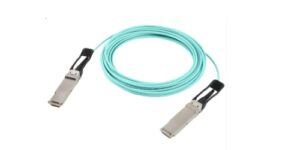 25G SFP28 to SFP28 Active Optical Cablefrom $47,00
25G SFP28 to SFP28 Active Optical Cablefrom $47,00 -
 40G QSFP+ to QSFP+ Active Optical Cablefrom $76,00
40G QSFP+ to QSFP+ Active Optical Cablefrom $76,00 -
 AOC-10G-10G-MM850from $24,00
AOC-10G-10G-MM850from $24,00
-
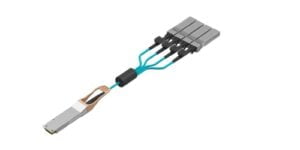 100G QSFP28 to 4X25G SFP28 Breakout Active Optical Cablefrom $180,00
100G QSFP28 to 4X25G SFP28 Breakout Active Optical Cablefrom $180,00 -
 100G QSFP28 to QSFP28 Active Optical Cablefrom $118,00
100G QSFP28 to QSFP28 Active Optical Cablefrom $118,00 -
 40G QSFP+ to 4x10G SFP+ Breakout Active Optical Cablefrom $89,00
40G QSFP+ to 4x10G SFP+ Breakout Active Optical Cablefrom $89,00
